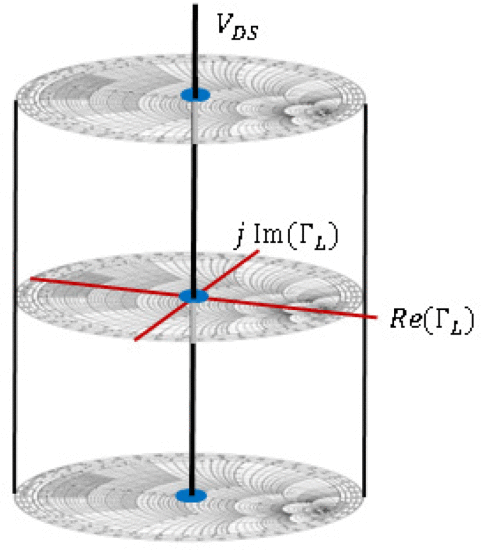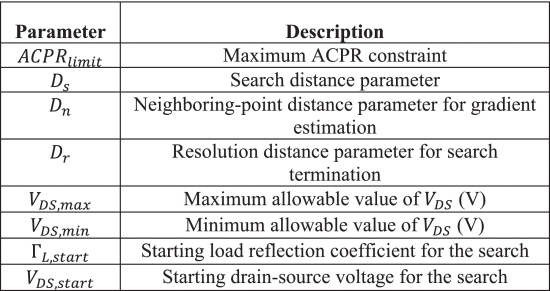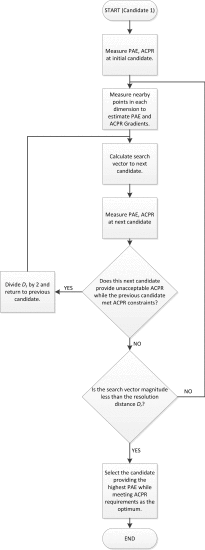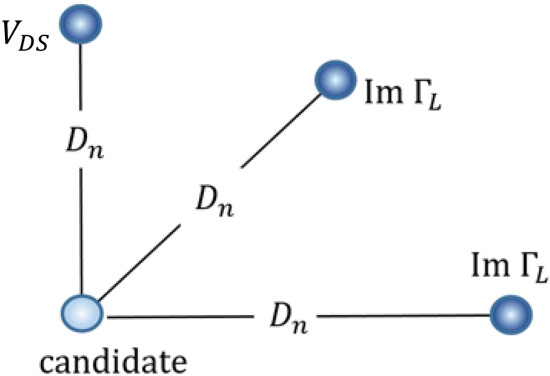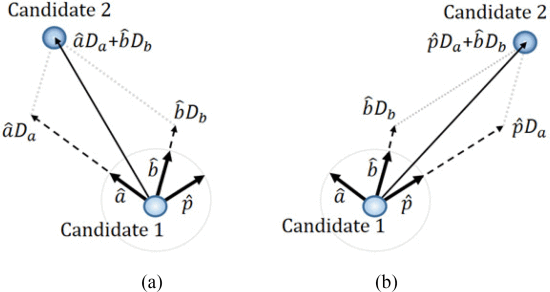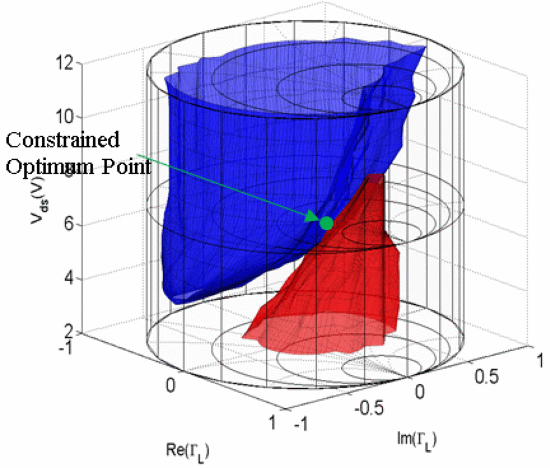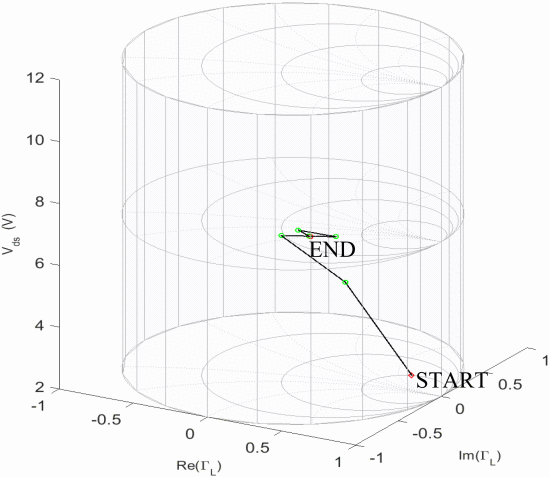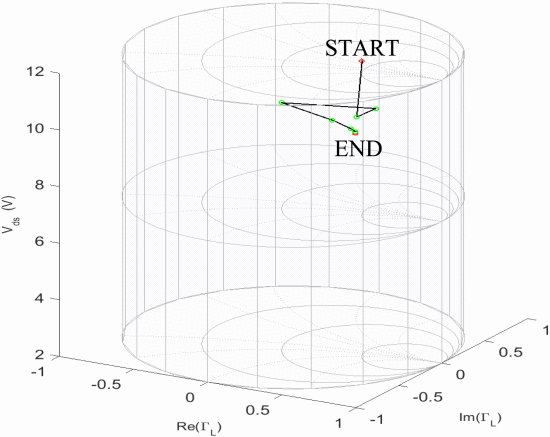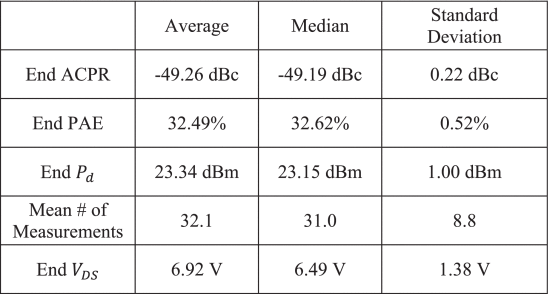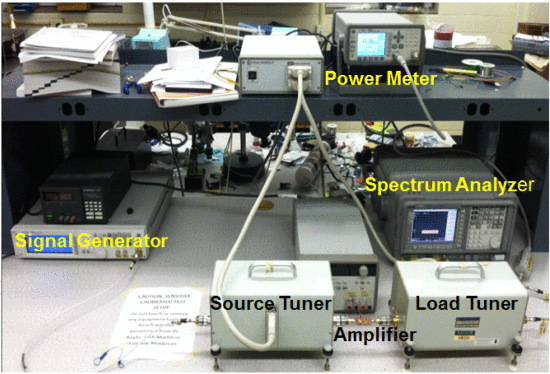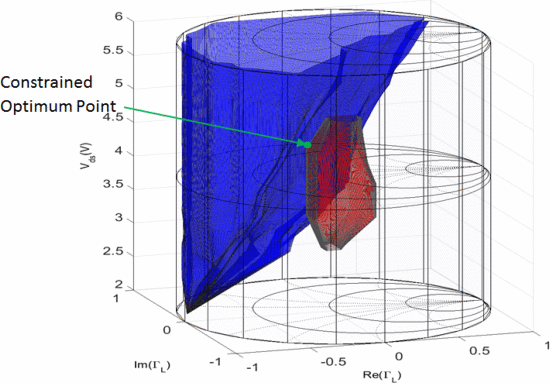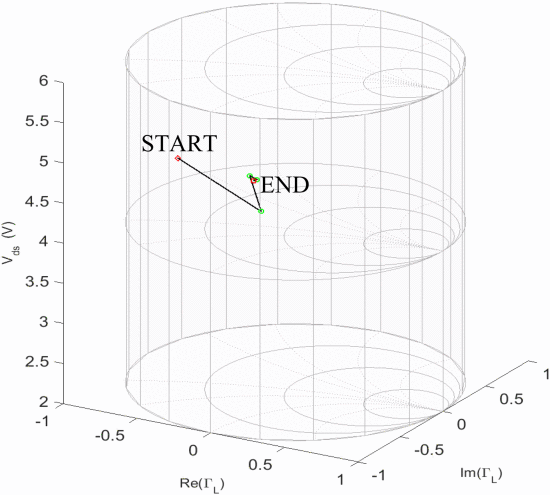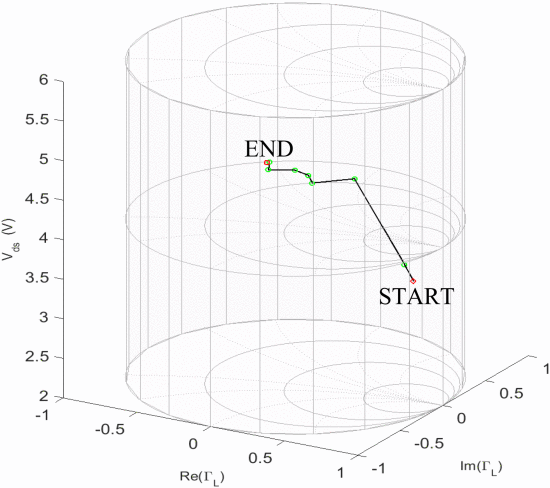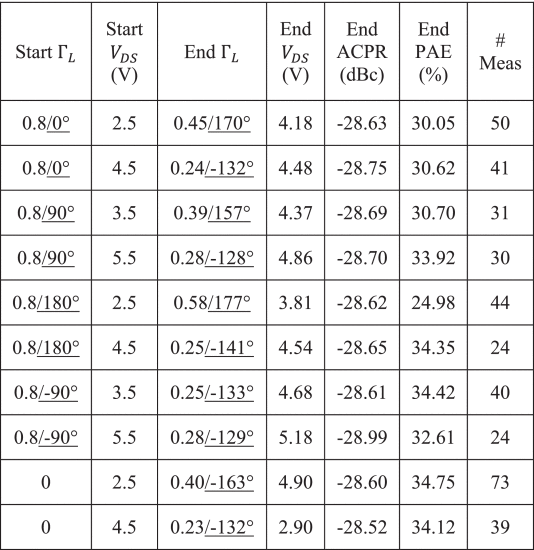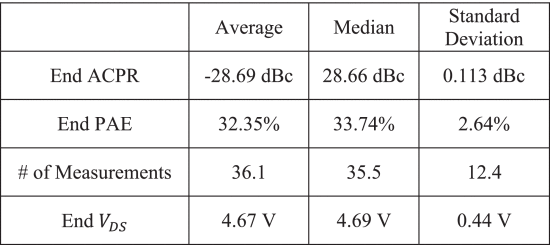Introduction
Future adaptive radar transmitters will need the ability to dynamically reconfigure in order to share the frequency spectrum more effectively without sacrificing transmitter power efficiency. The concept of adaptive radar has existed for several decades [1]–[4], but more recent work shows that adaptive radar technology is moving from theory to reality. A similar technology called cognitive radar has also been proposed. While adaptive radar systems adjust designs in real time for changing requirements, cognitive radar systems additionally learn from and respond to their environment [5], [6].
The use of adaptive and cognitive radars in sharing of the frequency spectrum in real time is a significantly challenging effort. Collaborative efforts between radar and communications using cognitive radio technology are beginning to emerge [7]. A recent paper discusses the concept of joint circuit and waveform codesign as a significant challenge problem facing radar operators [8]. This allows the intertwined impact of the circuit and the waveform to be jointly considered. Circuit optimizations and waveform optimizations should be designed to operate simultaneously in real time. Patton demonstrates the joint optimization of the waveform and receiver's matched filtering for autocorrelation and cross-correlation constraints [9], synthesis of a waveform based on a desired spectrum [10], and waveform optimization to meet constraints on both the autocorrelation and the waveform amplitude [11]. Jakabosky describes optimization of radar waveforms with the transmitter hardware “in the loop” to overcome the tradeoff of distortion versus transmission efficiency [12], and Ryan and Blunt demonstrate the hardware-in-the-loop optimization of polyphase-coded frequency-modulation waveforms using a linear amplification with nonlinear components power-amplifier architecture [13], [14]. Techniques for real-time circuit optimization that can be used in conjunction with waveform optimization techniques have also been recently introduced to the radar community. Real-time optimization of load impedance in a radar transmitter will require a variable matching circuit [15], [16]. Kingsley and Guerci have discussed implementation of a matching network for adaptive radar [15]. The literature shows that tuning of some matching circuits can be achieved in microseconds, which is fast enough for real-time optimization purposes. Previous works by the authors have presented algorithms for fast circuit tuning, including the ability to tune the load reflection coefficient presented to an amplifier to maximize the power-added efficiency (PAE) under constraints on the adjacent-channel power ratio (ACPR), using the Smith chart as a search space [17], [18]. ACPR and PAE are both significantly dependent on load impedance [19]. Instead of the ACPR, the circuit optimization can be performed specifically to require spectral mask compliance [20]. Our development of the Smith tube, a multidimensional optimization space, has allowed additional parameters to be modified in the optimization, including waveform bandwidth [21] and input power [22]. In addition, the optimization can include additional constraints, such as requiring the output power to be above a specified minimum value [23].
The purpose of this paper is to demonstrate a joint optimization of the power-amplifier matching circuit impedance and an amplifier device bias voltage to maximize the efficiency of the amplifier while remaining within constraints on the ACPR. Our work builds on the following previous innovations from the literature: 1) PAE and ACPR dependence on load impedance and bias and 2) fast algorithms for circuit optimization. The need for joint circuit and bias optimization is developed by several works that show the dependence of PAE and ACPR on bias voltage and impedance. This literature includes applications such as envelope modulation of gate voltage [24], adjusting drain voltage and current to improve PAE [25], variation of input and output bias voltages [26], optimizing bias and RF power for efficiency while examining drain voltage and RF input [27], and using a dc–dc converter to simultaneously optimize input waveform and dc voltage [28]. Other literature shows how load resistance impacts bias point and power efficiency [29], how the optimum load impedances for power and efficiency vary with bias voltage on the Smith chart [30], how optimum PAE varies with bias [31], and how to select matching circuit impedance and bias voltage for ideal peaking and carrier performance using Doherty amplifiers [32]. Recent work by the authors has introduced the bias Smith tube, which is a three-dimensional extension of the Smith chart where the vertical dimension is drain voltage [33]. The bias Smith tube is shown in Fig. 1.
Bias Smith tube. The vertical axis represents a bias voltage (drain–source voltage
Several circuit optimization techniques have been developed in the literature. Sun and Lau implement a genetic algorithm for antenna matching based on VSWR requirements [34], [35]. Qiao also uses a genetic algorithm for a reconfigurable amplifier [36]. However, genetic algorithms can be slower than other algorithm types for certain impedance-matching applications [37]. Balachandran demonstrates the application of the sequential unconstrained minimization technique and the automated Lagrangian penalty function technique in designing a power converter [38]. The constrained optimization for PAE while meeting ACPR requirements is an example of an optimization involving more than one objective. The literature describes several methods for optimizing in multi-objective situations [39]–[44].
The rest of this paper describes the presented algorithm and shows simulation and measurement results of algorithm testing. Section II describes the bias Smith tube search algorithm in detail. Section III shows simulation results for this algorithm. Section IV shows measurement results for this algorithm. Section V provides some conclusions and suggestions for future work.
Algorithm Description
The presented algorithm simultaneously optimizes the load reflection coefficient
Once those inputs have been defined, the ![]()
A flowchart describing the basic progression of the algorithm is shown in Fig. 2. After the algorithm normalizes the
Measured
Unit vectors ![]()
The partial derivatives in (2) are approximated as follows, where ![]()
The unit vector in the direction of PAE steepest ascent is calculated using a gradient estimation:
![]()
The ACPR gradient ![]()
A unit vector ![]()
If the measurement at the current candidate location gives an ACPR that was greater than the ACPR limit (out of compliance), then the step vector is defined by
![]()
![]()
This search vector construction is shown in Fig. 4(a).
Search vectors in the Smith tube in the cases where (a) candidate 1 ACPR is outside the ACPR limit and (b) candidate 1 ACPR is inside the ACPR limit.
The ACPR contours may not always be convex; however, the authors have observed that the ACPR contours are usually close enough to being convex in the regions near the desired optimum for the search algorithm to provide a consistent quality of results for all start locations in the Smith tube. Since (3) goes to zero on the ACPR limit contour and (4) goes to zero on the Pareto front, the vector addition in (2) should converge to the desired optimum.
A second possibility based on a candidate measurement is that the ACPR at the candidate will be less than or equal to the ACPR limit, which means that the present candidate is in spectral compliance. In that case, the next step, which the algorithm takes, is defined by
![]()
The only difference between (12) and (9) is that the vector in (12) has a component in the direction of steepest ascent for PAE, whereas the vector in (9) has a component in the direction of steepest descent for the ACPR. This difference recognizes which of those two parameters needs improvement. If the ACPR limit is being met then the algorithm tries to improve PAE. If the ACPR limit is not being met then the algorithm tries to improve the ACPR. Also note that
Before the algorithm can use the calculated step vector, it must first check to make sure that the new candidate location is still inside the Smith tube. If not, the algorithm chooses the closest location to the calculated point that is inside the Smith tube to be the next candidate point. The algorithm then moves to take a measurement at the new location and performs the following checks.
The step to a new candidate point is allowed to leave the ACPR acceptable region one time. After the first time, if the step took the search from a candidate inside the ACPR acceptable region to a candidate outside the ACPR acceptable region, divide the search distance parameter
Ds Ds Dr If both the new candidate and the old candidate are inside the ACPR acceptable region, but the PAE at the new candidate is lower (worse) than the PAE at the old candidate, divide
Ds
The presented search algorithm repeats the process of candidate measurements and steps to new candidates until the magnitude of the step vector
Simulation Results
The presented algorithm was tested in simulation using the Advanced Design System (ADS) software from Keysight Technologies. In ADS, a Modelithics model of a Qorvo TGF2960 field-effect transistor was used. The search used an ACPR limit of −49 dBc and was tested from a total of 50 different start locations in the Smith tube. Simulations were performed using a CDMA2000 excitation waveform at a fixed center frequency of 3.3 GHz, input power
Fig. 5 shows the surface representing ACPR = −49 dBc and the surface representing PAE = 33.04%, which represents the largest PAE value that can be obtained within that ACPR limit. The point where the two surfaces intersect in that figure represents the optimum operating point as found by a brute force examination of the entire Smith tube, which requires hundreds of simulated points, taken by multiple load-pull simulations at varying
Surface for ACPR = −49 dBc (blue) and surface with PAE
Figs. 6 and 7 show examples for the search trajectories of the fast search algorithm from two different starting locations. These results are typical examples of the path that the algorithm will take to reach the optimum. Table II shows data for a few selected algorithm runs for various starting points throughout the
Simulation search trajectory for starting
Simulation search trajectory for starting
Tables II and III also show an additional significant result of the algorithm: its effect on the output power ![]()
Thus, the PAE can be increased by either increasing the output power
Measurement Results
In addition to the simulated algorithm runs in ADS, the presented algorithm was tested in measurement for 20 different starting points using a Maury Microwave Automated Tuner System. Fig. 8 shows the measurement setup for bench testing. The load impedance tuner provides the desired
Fig. 9 shows the surface representing ACPR = −28.5 dBc and the surface representing PAE = 32.19%, which represents the largest PAE value that can be obtained within the ACPR limit. The point where the two surfaces intersect in that figure represents the constrained optimum combination of
Acceptable region for the ACPR limit of −28.5 dBc and region with the PAE greater than 32.49%, taken from traditional load-pull measurements at multiple values of
Figs. 10 and 11 show the results of running the search algorithm from two different Smith tube starting locations. Table IV shows data for a few selected algorithm runs for various starting points throughout the Smith tube, and Table V shows statistics summarizing the algorithm's results for all 20 start locations that were measured.
Measurement search trajectory for starting
Measurement search trajectory for starting
For the most part, the results in Tables IV and V show consistent PAE results with some variation in the end locations due to the large region where the PAE and ACPR contours are close together, much like in simulation. However, the start location at
While the adjustment of drain bias voltage has been specifically examined in this paper, it is also possible to consider the real time, simultaneous optimization of the gate–drain voltage bias
This work represents an initial algorithm for the optimization of PAE and ACPR by simultaneous optimization of load impedance and bias voltage. As discussed earlier, in a practical radar system, output power and gain will also be important criteria of the radar transmitter amplifier. It is critical for the transmitted power of the radar to be sufficient to illuminate the target such that a reflection can be detected above the noise floor at the receiver. Such considerations could be used to derive a minimum output power of the transmitter and its power amplifier. This improvement of the search would include the minimum amplifier output power as an additional constraint in the bias Smith tube search, in a similar approach to that recently demonstrated in the Smith chart [23].
Conclusion
A fast search algorithm has been presented to find the combination of load reflection coefficient and drain voltage in the
ACKNOWLEDGMENT
The authors wish to thank Keysight Technologies for cost-free loan of the Advanced Design System software, and Modelithics for donation of model libraries through the Modelithics University Program. The authors are grateful to D. Macias of Baylor University for data collection during the revisions of this paper.

